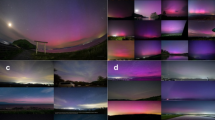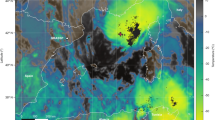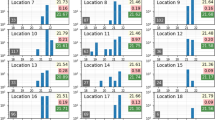Abstract
IT has long been accepted that auroral activity is associated, with magnetic disturbances. Observations inside the auroral zone show the relationship to be rather complex ; bright auroral displays are often observed during quiet magnetic conditions, and even in the greatest of magnetic storms visual aurorse are not always observed. On the other hand, well-exposed auroral spectra are always obtained during these storms. The source of this emission lies in extensive glows, often above the threshold of vision, but of such low contrast that observers normally do not recognize or report them. Changes in the colour of the night sky can be observed on colour film exposed during such storms. The forbidden atomic oxygen lines and the first negative, first positive and second positive bands of molecular nitrogen are all enhanced in these glows.
This is a preview of subscription content, access via your institution
Access options
Subscribe to this journal
Receive 51 print issues and online access
$199.00 per year
only $3.90 per issue
Buy this article
- Purchase on SpringerLink
- Instant access to full article PDF
Prices may be subject to local taxes which are calculated during checkout
Similar content being viewed by others
References
Gregory, J. B., Nature, 181, 753 (1958).
Author information
Authors and Affiliations
Rights and permissions
About this article
Cite this article
SANDFORD, B. Enhancement of Night-Sky Molecular Nitrogen Emission in Polar Cap Absorption Events. Nature 190, 245–246 (1961). https://doi.org/10.1038/190245a0
Issue date:
DOI: https://doi.org/10.1038/190245a0



